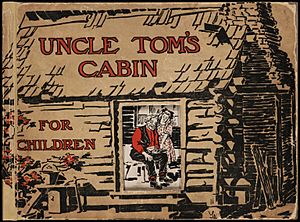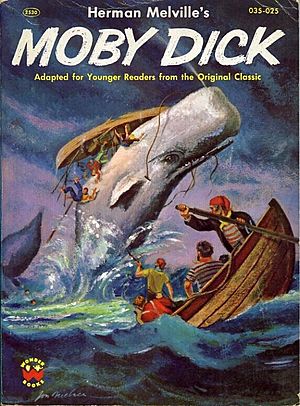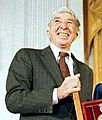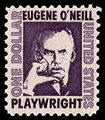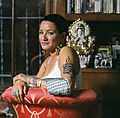American literature facts for kids
American literature is the collection of stories, poems, and plays written in the United States. Before the U.S. became a country, the British colonies here were very much like English literature. But over time, American literature grew into its own unique style.
Contents
Early American Writers
The first American writings came from the New England Colonies. During the time of the American Revolutionary War, important political writings were made by people like Samuel Adams, Benjamin Franklin, and Thomas Paine. After the war, Thomas Jefferson's United States Declaration of Independence showed his skill as a writer.
The first novels in America were published in the late 1700s and early 1800s. After the War of 1812, Americans wanted their own special literature. This led to new famous writers like Washington Irving and Edgar Allan Poe.
Literature and Social Change
The fight against slavery inspired many powerful writings. William Lloyd Garrison wrote strongly against slavery. Harriet Beecher Stowe wrote her famous book, Uncle Tom's Cabin, which showed the harshness of slavery. Also, former enslaved people wrote their own stories, like Frederick Douglass's Narrative of the Life of Frederick Douglass, an American Slave. These books helped people understand the need to end slavery.
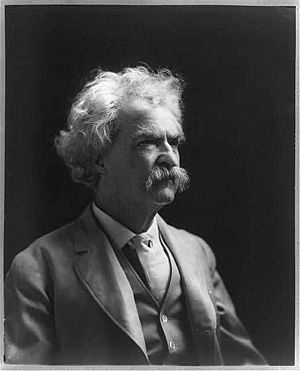
Great Writers of the 19th Century
Herman Melville (1819–1891) is known for his books Moby-Dick and Billy Budd. America's two most important poets in the 1800s were Walt Whitman (1819–1892) and Emily Dickinson (1830–1886).
Mark Twain (1835–1910), whose real name was Samuel Langhorne Clemens, was the first major American writer not from the East Coast. He wrote classic stories like The Adventures of Tom Sawyer and Adventures of Huckleberry Finn. Henry James (1843–1916) wrote interesting novels like The Turn of the Screw.
American Literature in the 20th Century
At the start of the 1900s, important American novelists included Edith Wharton (1862–1937), Stephen Crane (1871–1900), Theodore Dreiser (1871–1945), and Jack London (1876–1916). Writers like Gertrude Stein (1874–1946) started to experiment with new writing styles.
After World War I, many American writers felt disappointed and lost. The stories of F. Scott Fitzgerald (1896–1940) captured the feeling of the 1920s. Ernest Hemingway (1899–1961) became famous for books like The Sun Also Rises and A Farewell to Arms. He won the Nobel Prize in Literature in 1954.
William Faulkner (1897–1962) wrote powerful novels like The Sound and the Fury. American plays became famous around the world in the 1920s and 1930s, thanks to writers like Eugene O'Neill. He won four Pulitzer Prizes and the Nobel Prize in Literature. Later in the 20th century, famous playwrights included Tennessee Williams and Arthur Miller. American musicals also became very popular.
During the Great Depression, writers like John Steinbeck (1902–1968) wrote about the struggles of everyday people. His novel The Grapes of Wrath is a famous example. After World War II, many popular books were written, such as Harper Lee's To Kill a Mockingbird. John Updike wrote Rabbit, Run (1960), and Philip Roth explored what it means to be Jewish in America.
Since the 1970s, a style called postmodernism has been important. Also, literature by different ethnic and minority groups has grown a lot.
Nobel Prize in Literature winners (American authors)

- 1930: Sinclair Lewis (novelist)
- 1936: Eugene O'Neill (playwright)
- 1938: Pearl S. Buck (biographer and novelist)
- 1948: T. S. Eliot (poet and playwright)
- 1949: William Faulkner (novelist)
- 1954: Ernest Hemingway (novelist)
- 1962: John Steinbeck (novelist)
- 1976: Saul Bellow (novelist)
- 1978: Isaac Bashevis Singer (novelist, wrote in Yiddish)
- 1987: Joseph Brodsky (poet and essayist, wrote in English and Russian)
- 1993: Toni Morrison (novelist)
- 2016: Bob Dylan (songwriter)
Images for kids
-
Main reading room at the Library of Congress
-
Captain John Smith's A True Relation of Such Occurrences and Accidents of Noate as Hath Happened in Virginia ... (1608) is considered an early American literary work.
-
Washington Irving and his friends at Sunnyside
-
F. Scott Fitzgerald, photographed by Carl van Vechten, 1937
-
William Faulkner in 1954
-
Norman Mailer, photographed by Carl Van Vechten, 1948
-
Jonathan Franzen at the 2008 Brooklyn Book Festival
-
Walt Whitman, 1856
-
Sandra Cisneros, known for The House on Mango Street.
See also
 In Spanish: Literatura de Estados Unidos para niños
In Spanish: Literatura de Estados Unidos para niños


